Fortunately, I have never experienced the misfortune of hitting a deer while driving. However, I have known plenty of people — from new drivers to octogenarians — who have! If a deer and your vehicle happen to cross paths, there are crucial things you need to do in regard to safety, insurance, and legal concerns.
Before we dive into what you need to do if you hit a deer while driving, let’s look at a few precautionary measures that might prevent such an incident from occurring in the first place.
Hot to Prevent Hitting a Deer While Driving
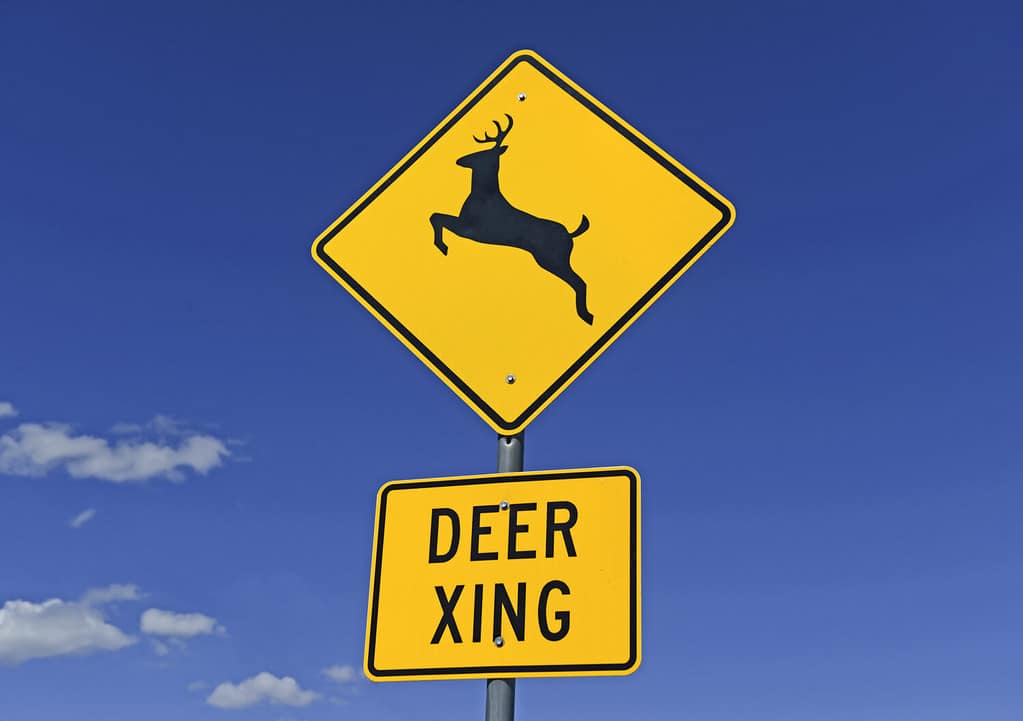
Deer crossing signs are for humans, not deer.
©nyker/Shutterstock.com
Use Beam Headlights
Especially if you are on a rural or deserted road, keep your headlights on high, especially during the rutting season. Don’t listen to those who say to drive with your headlights off during dawn and dusk. That’s a recipe for an even larger disaster!
Look for Yellow Deer Crossing Signs
Don’t make the mistake of thinking those yellow deer crossing signs are for the deer. These bright signs indicate areas where deer commonly cross the road. Deer use distinctive travel patterns (usually the path of least resistance), and local governments place these signs where plentiful deer activity and/or deer collisions have occurred. If you see one, slow down and be alert.
Be Knowledgable About Rutting Season
Depending on where you live and the weather trends, the deer rutting season can last anywhere from mid-October to mid-to-late December. Rut season is peak breeding season, and the bucks will begin to act strangely in pursuit of does. They will become more visible than usual during the daytime hours, and then they will eventually be seen running or chasing females during the peak rut. This period (in Tennessee, where I live, late November to early December) brings about the bizarre behavior that may make a deer suitor chase his potential mate without regard to street signs or oncoming vehicles.
Be Extremely Cautious at Dawn and Dusk
As deer are most active as the sun rises and sets, be particularly vigilant about scanning the road.
Always Wear Your Seatbelt
Although New Hampshire is the only state that does not require a driver to wear a seatbelt when operating a motor vehicle, common sense prevails. It should go without saying, but limit distractions: put your phone in your glove box, only use steering wheel hands-free controls, and always keep your eyes on the road (not your passengers, your french fries, or the pen you dropped in the back seat).
What happens when you’ve taken precautions but still manage to hit a deer while driving?
1. Point of Impact

In many ways, deer are unpredictable creatures.
©Sean Thomforde/Shutterstock.com
First of all, don’t swerve. The deer may leap in the direction of your swerve. Worse yet, you could hit another vehicle head-on or do considerable damage to someone’s property. Why some advise speeding up is a mystery, but pushing down on the accelerator will only add to the impact. Hold onto your steering wheel tightly and apply the brakes. Braking is the best way to mitigate damage to you, your passengers, your vehicle, and the deer.
2. Don’t Panic
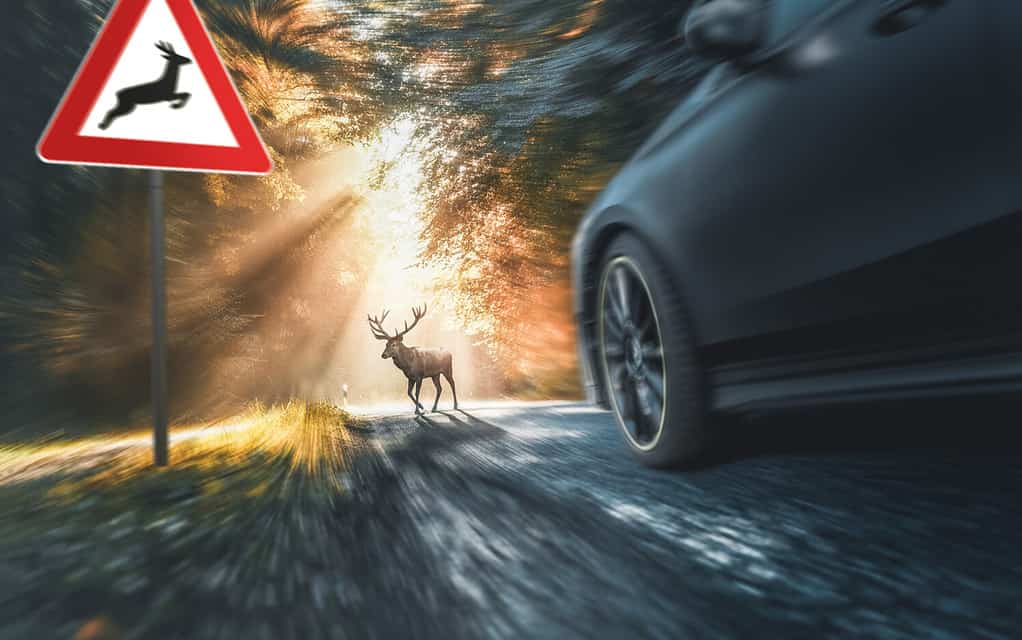
Keep a level head if you hit a deer while driving.
©m.mphoto/Shutterstock.com
It’s easy to say but difficult to do: Don’t panic. Take a deep breath and focus so you can clearly assess the situation. In your anxious state, your first instinct might be to get out of the car. Don’t get out of your car! You still have a couple of crucial steps to take.
3. Get Off of the Road
To avoid another collision, move your vehicle off of the road immediately! Even in the daytime, turn your hazard lights on and move your vehicle off of the road to the nearest safe location that you can find. If possible, move off of an interstate/highway shoulder, which is extremely dangerous! Move your vehicle into a parking lot, a neighborhood side road, or even a driveway. Keep your hazard lights on.
4. Make Sure That Nobody Is Injured
First of all, check yourself and your passengers for injuries. Be diligent in your questioning and your self-assessment because adrenaline can mask the pain of a minor or major injury.
5. Call the Police
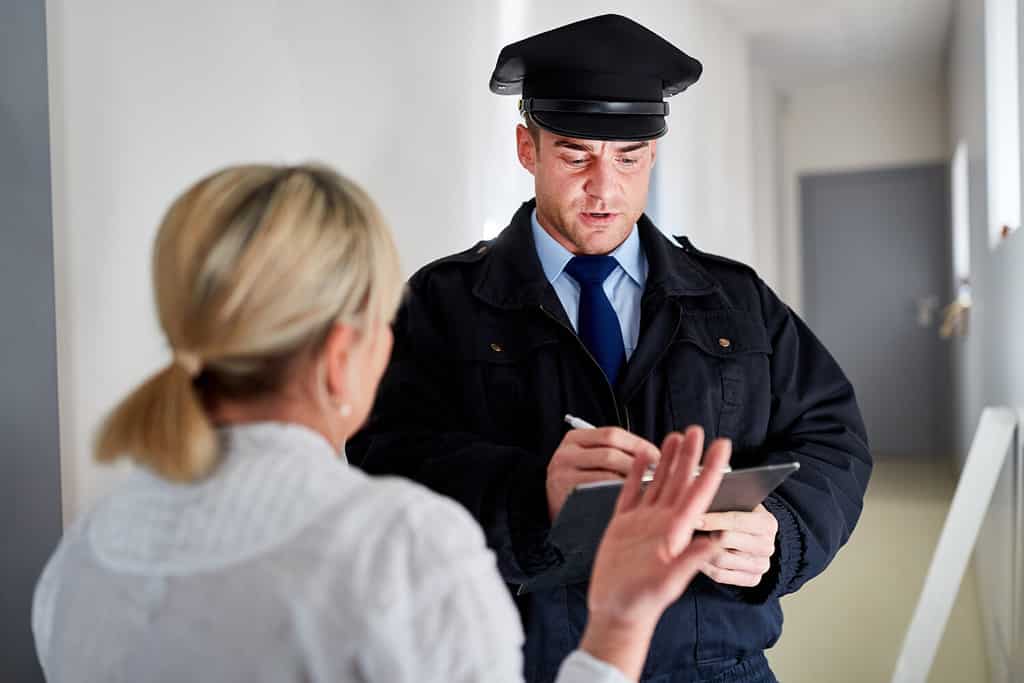
Always call the police, even if you think no injuries or damage exists.
©Robert Kneschke/Shutterstock.com
Now is the time to call 9-1-1. Even if you think there’s no damage (and there probably is), if you’re following protocol, you don’t know if there’s damage. You haven’t gotten out of your vehicle yet. If the deer is still close by, the police will take care of notifying the proper jurisdiction to take care of the animal. If you are fairly certain the deer is still alive, you might go ahead and give your local wildlife authority or game warden a call. Give them a heads-up courtesy call to briefly explain the circumstances. Before you hang up, let the authorities know whether the deer is a hazard for other travelers.
6. Assess the Damage
If the deer has dashed away beyond visibility or is nowhere remotely close by, you may now get out of your car. If you advise 9-1-1 that there are no injuries, you may have a bit longer of a wait. Now is the time to take notes about exactly what happened while the memory is fresh. Additionally, walk all around the vehicle and take photos to document any damage. Most insurance companies advise that you call them and let them know prior to any damage being assessed. However, they are insurance companies. Wait until you have an official police report if needed, before you call your insurance company.
7. Know (or Look Up) Your State’s Roadkill Policy
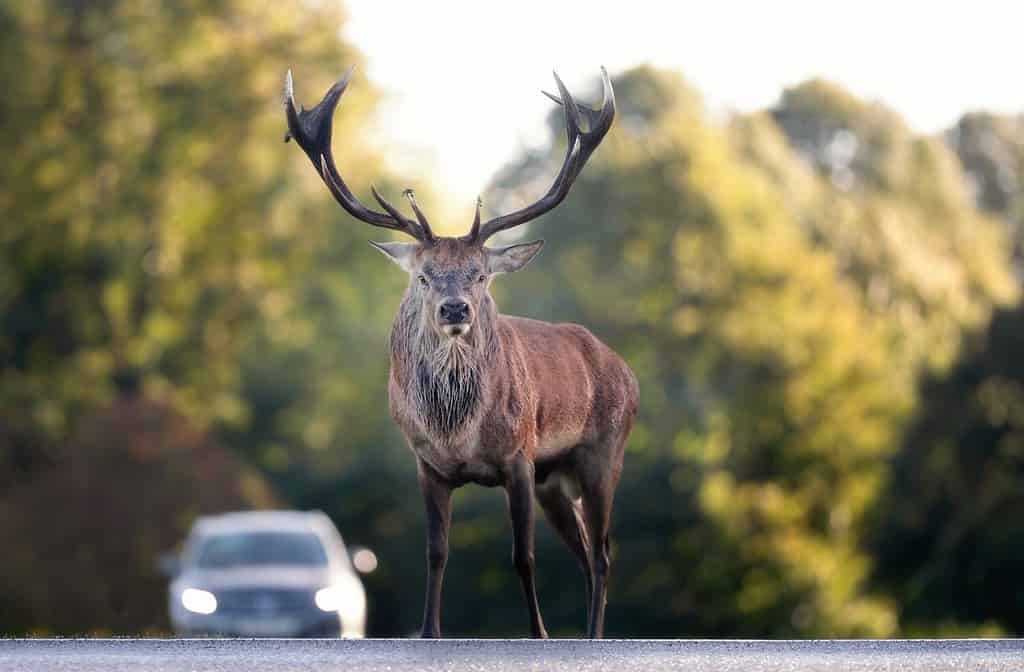
Many states allow you to keep a deer you hit while driving.
©Giedriius/Shutterstock.com
Unless the deer was only mildly injured and able to escape, it’s likely that the deer is either dead or close to it. In fact, most times, the authorities will be required to euthanize the deer to save it from further pain and suffering. In the absence of any deer abnormalities, such as Chronic Wasting Disease (CWD), assume that the deer is edible. You know that it is fresh, no matter if it’s subzero temperatures or the dog days of summer.
Additionally, venison is extremely healthy. Deer meat offers a high-quality red meat that is extremely low in saturated fat. Venison contains roughly one-third of the saturated fat as beef and almost half of the calories. In fact, many cardiologists recommend it to their patients. Venison is also a great source of iron, zinc, and essential B vitamins.
A quarter of the United States now holds laws that allow a citizen to keep their roadkill. The regulations vary greatly among these states and even from county to county, so be sure to check with your local government before taking your Bambi to the closest deer meat processing establishment. Don’t care for the taste of deer? Call friends who love venison and who would cherish some low-cost meat for their freezer. Of course, you or they will have to get the deer transported to the processing facility and pay when the meat is ready to be picked up.
Another option is to donate the deer meat. Numerous programs exist to feed the hungry with unwanted wildlife roadkill. Search in your area for processors that take deer to feed the hungry and homeless. You won’t have to pay for it, and you will provide great value to your community.
8. Inform the Authorities
When the local experts arrive, give them your account (from your notes) of exactly what happened. Based on your call and their assessment of your situation, the police may want to have an EMT check you out to see if you need to go to the hospital for further examination. If the police need to fill out an accident report, make sure to do your part to cooperate fully and read it over thoroughly before you sign it. You can request a copy of the report be emailed and/or sent to you, but in many cases, you will have to go to the courthouse in the next couple of business days to obtain a copy.
9. Discern Your Vehicle’s Driveability

Be sure to stay far away from a deer that has been hit.
©Ronald Rampsch/Shutterstock.com
Don’t assume that your vehicle is safe to drive. The authorities will help you, but you need to look for certain possible problems. Make sure that your headlights, taillights, and brake lights are working properly, especially at dusk or after dark. Look for leaking fluids, detached parts, damaged tires, or faulty hood or door closing. If you deem the vehicle safe, drive straight home. For a myriad of reasons, including safety and liability, you don’t need to make any pit stops.
10. Follow Up
Once you get home, call your insurance company if needed. Tell them the exact time and a detailed account of the collision. Let them know when the accident report will be ready, and ask if there is anything else you need to do on your end. Make a list of actions for the next few days: tend to injuries (if applicable), obtain a copy of the police report, and follow through with your insurance agent.
Relax, and keep the rest of your day as low-key as possible. You have experienced a stressful situation, and you deserve time to unwind and reflect. Don’t beat yourself up — you didn’t cause this to happen. Instead, let it be a learning experience.
One Final Thought: Liability
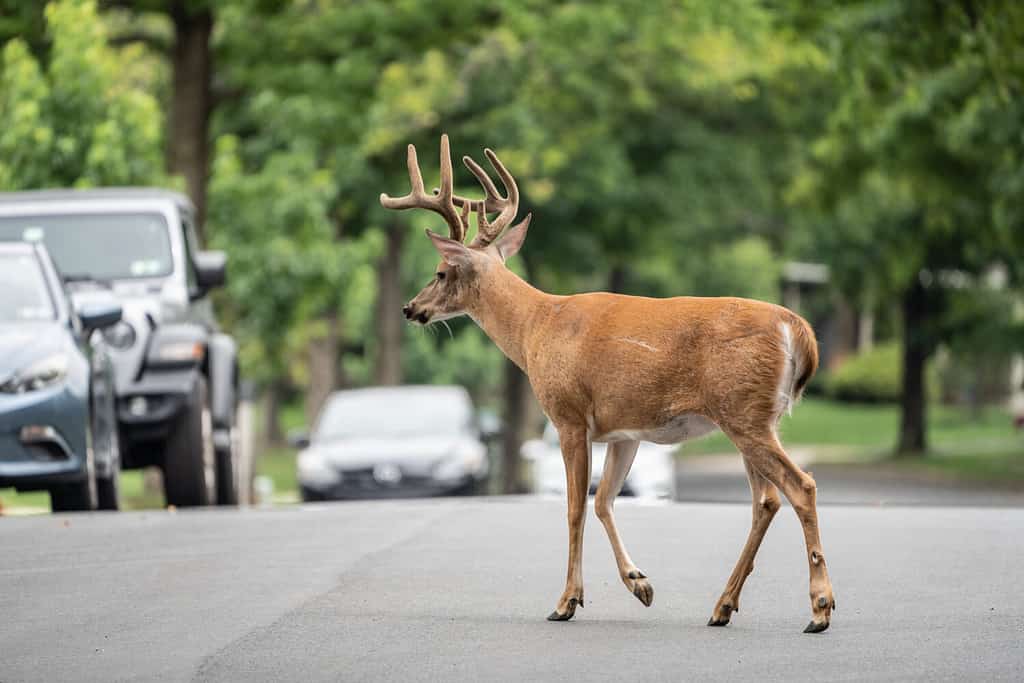
Deer tend to be most active as the sun rises and sets.
©Amy Lutz/Shutterstock.com
There is one big question most people have regarding hitting a deer with a vehicle: Is it against the law to leave the scene if you’ve hit a deer? It depends. If there is property damage of $500 or more (which is likely), then you must legally report the accident to the authorities for purposes of documentation and insurance. If there is no or minimal damage, is it illegal to drive away from a deer collision? Technically, no. In the majority of states, it’s not. However, be certain you are cognizant of the laws in your own state and district.
Though it may not be illegal to leave the scene after hitting a deer, it’s certainly unethical. First of all, if you leave the deer on the road, you’re leaving another potentially disastrous situation. Especially if it’s close to or after dark, a prone deer lying on the ground may be harder to see than the upright animal you hit previously. No ethical, moral person wants bodily harm to come to innocent citizens, no matter who those citizens are.
Secondly, as previously mentioned, deer meat, if undiseased, is extremely healthy. Taking the time to call the authorities and donate the meat to a local charity is the right thing to do. In sum, while it may not be unlawful in your state to leave the scene after hitting a deer, it is an ethical responsibility to do so as an upstanding citizen.
Thank you for reading! Have some feedback for us? Contact the AZ Animals editorial team.








